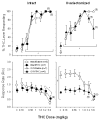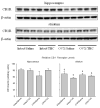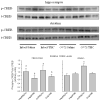Ovarian hormones and chronic administration during adolescence modify the discriminative stimulus effects of delta-9-tetrahydrocannabinol (Δ⁹-THC) in adult female rats
- PMID: 22705493
- PMCID: PMC3402337
- DOI: 10.1016/j.pbb.2012.06.008
Ovarian hormones and chronic administration during adolescence modify the discriminative stimulus effects of delta-9-tetrahydrocannabinol (Δ⁹-THC) in adult female rats
Abstract
Marijuana abuse during adolescence may alter its abuse liability during adulthood by modifying the interoceptive (discriminative) stimuli produced, especially in females due to an interaction with ovarian hormones. To examine this possibility, either gonadally intact or ovariectomized (OVX) female rats received 40 intraperitoneal injections of saline or 5.6 mg/kg of Δ⁹-THC daily during adolescence, yielding 4 experimental groups (intact/saline, intact/Δ⁹-THC, OVX/saline, and OVX/Δ⁹-THC). These groups were then trained to discriminate Δ⁹-THC (0.32-3.2 mg/kg) from saline under a fixed-ratio (FR) 20 schedule of food presentation. After a training dose was established for the subjects in each group, varying doses of Δ⁹-THC were substituted for the training dose to obtain dose-effect (generalization) curves for drug-lever responding and response rate. The results showed that: 1) the OVX/saline group had a substantially higher mean response rate under control conditions than the other three groups, 2) both OVX groups had higher percentages of THC-lever responding than the intact groups at doses of Δ⁹-THC lower than the training dose, and 3) the OVX/Δ⁹-THC group was significantly less sensitive to the rate-decreasing effects of Δ⁹-THC compared to other groups. Furthermore, at sacrifice, western blot analyses indicated that chronic Δ⁹-THC in OVX and intact females decreased cannabinoid type-1 receptor (CB1R) levels in the striatum, and decreased phosphorylation of cyclic adenosine monophosphate response element binding protein (p-CREB) in the hippocampus. In contrast to the hippocampus, chronic Δ⁹-THC selectively increased p-CREB in the OVX/saline group in the striatum. Extracellular signal-regulated kinase (ERK) was not significantly affected by either hormone status or chronic Δ⁹-THC. In summary, these data in female rats suggest that cannabinoid abuse by adolescent human females could alter their subsequent responsiveness to cannabinoids as adults and have serious consequences for brain development.
Copyright © 2012 Elsevier Inc. All rights reserved.
Figures





Similar articles
-
Long-term behavioral and pharmacodynamic effects of delta-9-tetrahydrocannabinol in female rats depend on ovarian hormone status.Addict Biol. 2011 Jan;16(1):64-81. doi: 10.1111/j.1369-1600.2010.00227.x. Addict Biol. 2011. PMID: 21158010 Free PMC article.
-
Chronic Δ9-Tetrahydrocannabinol during Adolescence Differentially Modulates Striatal CB1 Receptor Expression and the Acute and Chronic Effects on Learning in Adult Rats.J Pharmacol Exp Ther. 2016 Jan;356(1):20-31. doi: 10.1124/jpet.115.227181. Epub 2015 Oct 13. J Pharmacol Exp Ther. 2016. PMID: 26462539 Free PMC article.
-
Cannabinoid agonists differentially substitute for the discriminative stimulus effects of Delta(9)-tetrahydrocannabinol in C57BL/6J mice.Psychopharmacology (Berl). 2008 Jul;198(4):487-95. doi: 10.1007/s00213-007-0900-2. Epub 2007 Aug 3. Psychopharmacology (Berl). 2008. PMID: 17673980 Free PMC article.
-
Brain regional differences in CB1 receptor adaptation and regulation of transcription.Life Sci. 2013 Mar 19;92(8-9):446-52. doi: 10.1016/j.lfs.2012.08.023. Epub 2012 Aug 24. Life Sci. 2013. PMID: 22940268 Free PMC article. Review.
-
Self-administration of cannabinoids by experimental animals and human marijuana smokers.Pharmacol Biochem Behav. 2005 Jun;81(2):285-99. doi: 10.1016/j.pbb.2005.01.026. Pharmacol Biochem Behav. 2005. PMID: 15932767 Free PMC article. Review.
Cited by
-
Sex and Gender Differences in the Effects of Novel Psychoactive Substances.Brain Sci. 2020 Sep 3;10(9):606. doi: 10.3390/brainsci10090606. Brain Sci. 2020. PMID: 32899299 Free PMC article. Review.
-
The relationship between gender and pharmacology.Curr Res Pharmacol Drug Discov. 2024 Jun 18;7:100192. doi: 10.1016/j.crphar.2024.100192. eCollection 2024. Curr Res Pharmacol Drug Discov. 2024. PMID: 39101002 Free PMC article.
-
Comparison of the discriminative stimulus and response rate effects of Δ9-tetrahydrocannabinol and synthetic cannabinoids in female and male rats.Drug Alcohol Depend. 2017 Mar 1;172:51-59. doi: 10.1016/j.drugalcdep.2016.11.035. Epub 2017 Jan 11. Drug Alcohol Depend. 2017. PMID: 28130989 Free PMC article.
-
Evaluation of Sex Differences in Preclinical Pharmacology Research: How Far Is Left to Go?Pharmaceuticals (Basel). 2023 May 24;16(6):786. doi: 10.3390/ph16060786. Pharmaceuticals (Basel). 2023. PMID: 37375734 Free PMC article. Review.
-
Hormonal status and age differentially affect tolerance to the disruptive effects of delta-9-tetrahydrocannabinol (Δ(9)-THC) on learning in female rats.Front Pharmacol. 2015 Jul 2;6:133. doi: 10.3389/fphar.2015.00133. eCollection 2015. Front Pharmacol. 2015. PMID: 26191005 Free PMC article.
References
-
- Alici T, Appel JB. Increasing the selectivity of the discriminative stimulus effects of delta 9-tetrahydrocannabinol: complete substitution with methanandamide. Pharmacol Biochem Behav. 2004;79:431–437. - PubMed
-
- Balster RL, Prescott WR. Delta 9-tetrahydrocannabinol discrimination in rats as a model for cannabis intoxication. Neurosci Biobehav Rev. 1992;16:55–62. - PubMed
-
- Breivogel CS, Childers SR, Deadwyler SA, Hampson RE, Vogt LJ, Sim-Selley LJ. Chronic delta9-tetrahydrocannabinol treatment produces a time-dependent loss of cannabinoid receptors and cannabinoid receptor-activated G proteins in rat brain. J Neurochem. 1999;73:2447–2459. - PubMed
-
- Carlstrom L, Ke ZJ, Unnerstall JR, Cohen RS, Pandey SC. Estrogen modulation of the cyclic AMP response element-binding protein pathway. Effects of long-term and acute treatments. Neuroendocrinology. 2001;74:227–243. - PubMed
-
- Casu MA, Pisu C, Sanna A, Tambaro S, Spada GP, Mongeau R, Pani L. Effect of delta9-tetrahydrocannabinol on phosphorylated CREB in rat cerebellum: an immunohistochemical study. Brain Res. 2005;1048:41–47. - PubMed
Publication types
MeSH terms
Substances
Grants and funding
LinkOut - more resources
Full Text Sources
Miscellaneous

